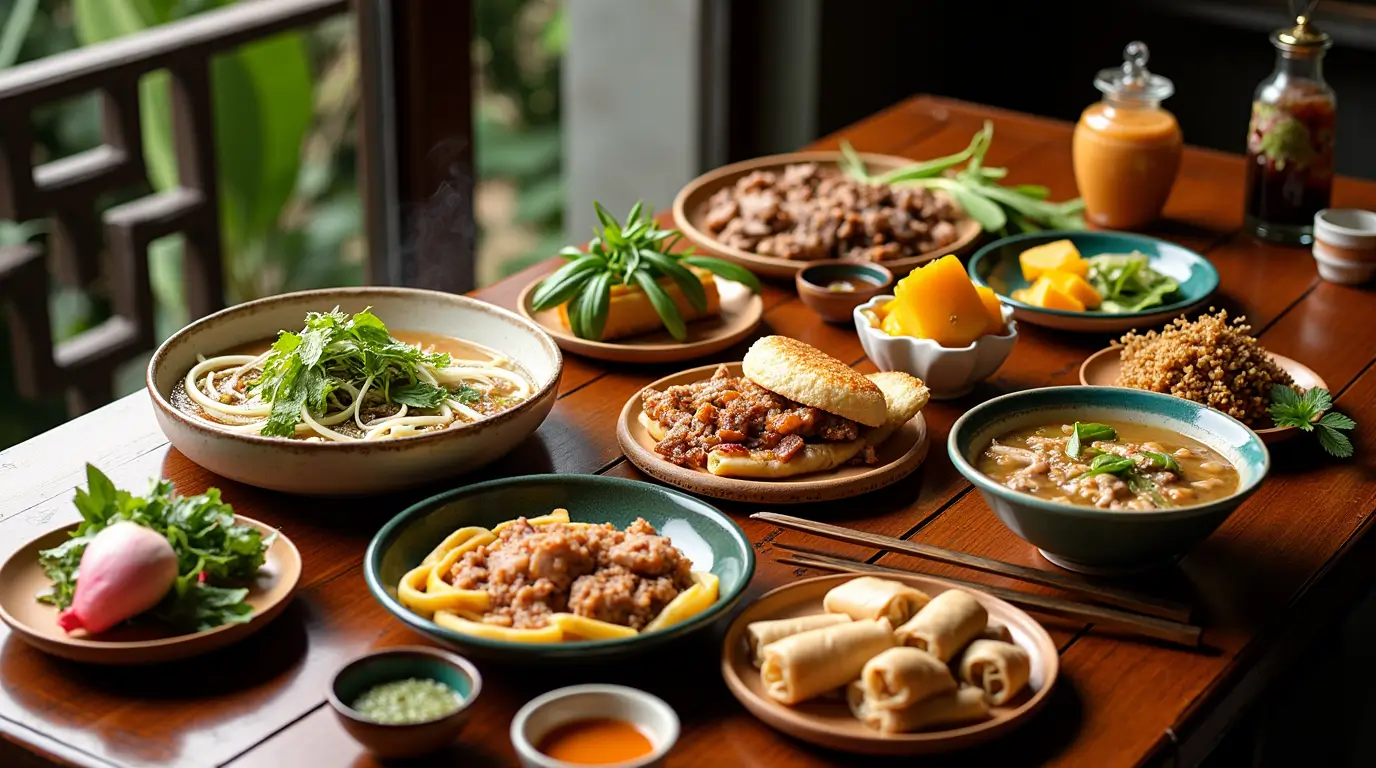Table of Contents
Table of Contents
Introduction
Vietnamese cuisine is renowned worldwide for its fresh ingredients, delicate balance of flavors, and rich cultural heritage. From steaming bowls of phở in bustling Hanoi streets to refreshing bánh mì sandwiches sold from mobile vendors in Ho Chi Minh City, Vietnam’s gastronomic landscape is a testament to centuries of cultural exchange and adaptation. With a strong emphasis on herbs, vegetables, and well-rounded flavors—encompassing sweet, salty, sour, and spicy—it offers a culinary experience that is both comforting and exciting. This article will guide you through the history that shaped Vietnamese gastronomy, the key ingredients that define it, and the iconic dishes you simply must try. We will also explore local customs, modern innovations, and everything in between, painting a comprehensive picture of one of Southeast Asia’s most fascinating cuisines.
Culinary Context and History
Evolution Over Time
Vietnamese cuisine has developed over thousands of years, adapting to changing dynasties, colonial influences, and global trade. At its core, traditional Vietnamese cooking relies on fresh produce, minimal use of dairy and oil, and the artful combination of various tastes and textures to create harmony on the palate. This fundamental principle of balance is deeply rooted in Vietnamese culture, where cuisine is seen not only as sustenance but also as medicine and a source of communal identity.
The earliest records show that wet rice agriculture was established in the Red River Delta in Northern Vietnam around 3,000 years ago. Rice quickly became a staple, shaping not just the nation’s agricultural systems but also its culinary habits. As Vietnamese civilization expanded southward over the centuries, new crops and techniques were adopted. This led to a gradual blending of regional produce and cooking styles, giving rise to the diverse cuisine we know today.
Another significant aspect of Vietnam’s culinary development is its reliance on foraging and the utilization of local flora. From water spinach to bamboo shoots, wild herbs, and edible flowers, the Vietnamese kitchen has always taken advantage of what nature readily offers. This sensibility is partly due to Vietnam’s fertile soils and varied climate, which allow for an abundance of fresh produce year-round.
Historical, Cultural, and Geographical Influences
Chinese Influence (111 BCE to 939 CE and beyond):
Vietnam spent over a millennium under Chinese rule. Consequently, Chinese cooking techniques and ingredients—such as soy sauce, tofu, and the art of stir-frying—found their way into Vietnamese gastronomy. Even the tradition of using chopsticks originated from these lengthy periods of cultural exchange.
Champa Kingdom and Khmer Influences:
As Vietnam expanded southward, it absorbed territories previously belonging to the Champa Kingdom and the Khmer Empire. Consequently, new spices (including chilies introduced via maritime trade), cooking methods, and dishes were integrated into Vietnamese cuisine. These influences became especially pronounced in Central and Southern Vietnam, adding elements of heat and coconut-based sauces.
French Colonial Period (mid-19th century to 1954):
The French introduced various ingredients, cooking techniques, and eating habits that fundamentally altered Vietnamese diets. Baguettes, pâté, coffee, and custard desserts are some of the enduring legacies. Bánh mì, the iconic Vietnamese sandwich, is a prime example of the fusion of French bread with local fillings, such as pickled vegetables and fresh herbs.
American Influence (20th century):
During the Vietnam War and its aftermath, American presence brought items like condensed milk (popularized through Vietnamese iced coffee), steak cuts, and Western dining customs to the local table.
Global Trade and Migration:
Waves of Vietnamese migrants to countries like the United States, Australia, and France further spread Vietnamese cuisine globally. Simultaneously, returning diaspora communities introduced new global elements back into Vietnam, creating a dynamic fusion scene in recent years.
Vietnam’s long coastline also plays a key role in its cuisine. The abundant seafood from the Gulf of Tonkin and the South China Sea has shaped many beloved dishes, including fish-based broths, steamed clams, and grilled seafood specialties. Rivers, deltas, and mountainous regions each offer unique ingredients—freshwater fish, tropical fruits, and wild herbs—that enrich the national menu. This geographic diversity directly contributes to Vietnamese cuisine regional variations.
Major Events and Key Periods That Shaped Recipes and Ingredients
Introduction of Chilies (16th-17th century): Portuguese traders are believed to have introduced chilies to Southeast Asia. Vietnam gradually adopted them, especially in Central Vietnamese cuisine, which is known for its spiciness.
Colonization and Revolutions: Vietnam’s pursuit of independence influenced how food was distributed and consumed. During times of scarcity, such as in wartime, Vietnamese cooks became adept at making the most of modest ingredients, leading to dishes like cơm tấm (broken rice with grilled meats) that turn byproducts or lesser cuts into culinary delights.
Open Market Era (1986 onwards): After Vietnam opened its markets to global trade in the late 1980s (commonly referred to as the Đổi Mới reforms), the influx of international products and capital drastically expanded the availability of new ingredients. Chefs began experimenting with Western cheeses, wines, and cooking tools.
Regional Differences
Northern Vietnam:
Flavor Profile: Light, subtle flavors.
Common Dishes: Phở (soup noodles), bún chả (grilled pork with rice noodles), and chả cá Lã Vọng (turmeric-marinated fish).
Culinary Characteristics: Due to cooler climate, the dishes are less sweet and less spicy. Food tends to focus on clear broths, stir-fries, and hearty soups.
Central Vietnam:
Flavor Profile: Spicy, bold, and often salty.
Common Dishes: Bún bò Huế (spicy beef noodle soup), various small plates known collectively as món Huế.
Culinary Characteristics: Influenced by the imperial cuisine of the Nguyen Dynasty in Huế, dishes here emphasize complexity and presentation. The use of fresh chili peppers, shrimp paste, and fermented sauces is frequent.
Southern Vietnam:
Flavor Profile: Sweeter and more liberal use of herbs and vegetables.
Common Dishes: Hủ tiếu (southern noodle soup), cơm tấm (broken rice), bánh xèo (crispy pancake).
Culinary Characteristics: Thanks to a warm climate, tropical fruits, and year-round crop production, southern dishes are often characterized by abundant produce, coconut milk, and a balance of sweet-savory flavors.
Highlands and Coastal Areas:
Flavor Profile: Rustic, reliant on locally foraged or fished ingredients.
Common Dishes: Grilled meats, steamed dishes wrapped in banana leaves, fresh seafood plates along the coast.
Culinary Characteristics: Mountainous areas focus on hearty, warming foods with wild herbs, while coastal regions feast on seafood integrated with tangy or spicy sauces.
Key Ingredients and Local Products
Emblematic Foods
Fish Sauce (Nước Mắm):
Undoubtedly the backbone of Vietnamese cuisine, this amber-hued liquid is made from fermented fish and salt. It is used in marinades, dressings, dipping sauces, and soups, adding a distinct salty-sweet punch.
Rice (Gạo):
Rice is central—whether steamed, broken, or turned into noodles, crackers, and paper for spring rolls. In Vietnam, rice is more than just a grain; it symbolizes life and prosperity.
Rice Noodles (Bánh Phở, Bún, Hủ Tiếu):
Vietnam’s love affair with noodles can be seen in the countless varieties. Each type has its distinct texture and purpose: bánh phở for phở soup, bún for fresh vermicelli dishes like bún thịt nướng, and hủ tiếu for the southern-style noodle soups.
Herbs (Rau Thơm):
Vietnamese cooking hinges on an aromatic bouquet of herbs: Thai basil, mint, cilantro, perilla, Vietnamese coriander (rau răm), and sawtooth herb (ngò gai), among others. These herbs provide a fresh, clean note to many dishes.
Vegetables and Fruits:
Popular vegetables include water spinach (rau muống), morning glory, banana blossoms, and bamboo shoots. Tropical fruits like mango, papaya, pomelo, and jackfruit are widely used in both sweet and savory preparations.
Chilies and Spices:
Although Vietnamese cuisine is not always as spicy as its Thai counterpart, chilies are nevertheless present in dipping sauces, soups, and stir-fries. Spices like star anise, cinnamon, and cloves show up particularly in northern dishes and phở broth.
Proteins:
Pork and chicken are the most common meats, while beef is historically a luxury protein but now more accessible. Seafood—especially fish, shrimp, and squid—is abundant. Tofu and eggs are also integral components of many traditional and vegetarian dishes.
Seasonality and Its Impact on Traditional Dishes
Vietnam’s diverse climate—from the temperate north to the tropical south—means that different regions enjoy different prime seasons for certain crops. Spring and summer in the north are ideal for leafy greens, while the south can produce many fruits and vegetables year-round. Seasonal monsoons also play a part; in times of heavy rain, freshwater fish and wild herbs become more commonly used.
Seasonality plays a crucial role in Vietnamese cuisine, with special dishes appearing in certain seasons. For example, chè (sweet soups) made with specific fresh fruits are popular in the summer, while hot pots filled with root vegetables provide warmth and nourishment during cooler months. This deep connection to nature ensures that meals are not only flavorful but also aligned with the rhythms of the land.
The tradition of eating seasonally is deeply rooted in Vietnamese cuisine, which emphasizes freshness and balance. Many families prefer to shop daily in local markets, choosing items that are harvested or caught that morning. This practice ensures the vegetables, herbs, and fish retain maximum flavor and nutritional value, reinforcing the importance of nature’s rhythms in everyday meals.
Tips on Purchasing Key Ingredients
Fish Sauce: Look for reputable brands at Asian grocery stores. High-quality fish sauce usually has a shorter ingredient list: primarily anchovies and salt.
Rice Noodles: Available in dried form in most supermarkets with international sections. For the freshest results, check local Asian stores that might stock partially cooked or fresh noodles in the refrigerated section.
Herbs: Seek out Vietnamese or Thai basil, mint, and cilantro in well-stocked grocery stores or farmers’ markets. Certain specialty stores carry perilla and sawtooth herb, both crucial for an authentic flavor.
Meats and Seafood: For better quality and authenticity, shop at butchers or fishmongers who carry cuts and species used in Southeast Asian cooking, such as whole tilapia, shrimp with heads on, or thin cuts of beef labeled for stir-fries or soups.
Produce: When possible, patronize farmers’ markets for fresh vegetables and tropical fruits like mango, papaya, and dragon fruit.
Spices: Star anise, cinnamon sticks, and cloves for broth can be found in the spice aisle or in Asian markets. Fresh chilies are usually available in the produce section.
Must-Try Traditional Dishes of Vietnamese cuisine
Below are some emblematic Vietnamese dishes that capture the country’s culinary spirit. Each dish embodies the harmony of flavors—savory, sweet, sour, and sometimes spicy—that makes Vietnamese cuisine so special.
Phở
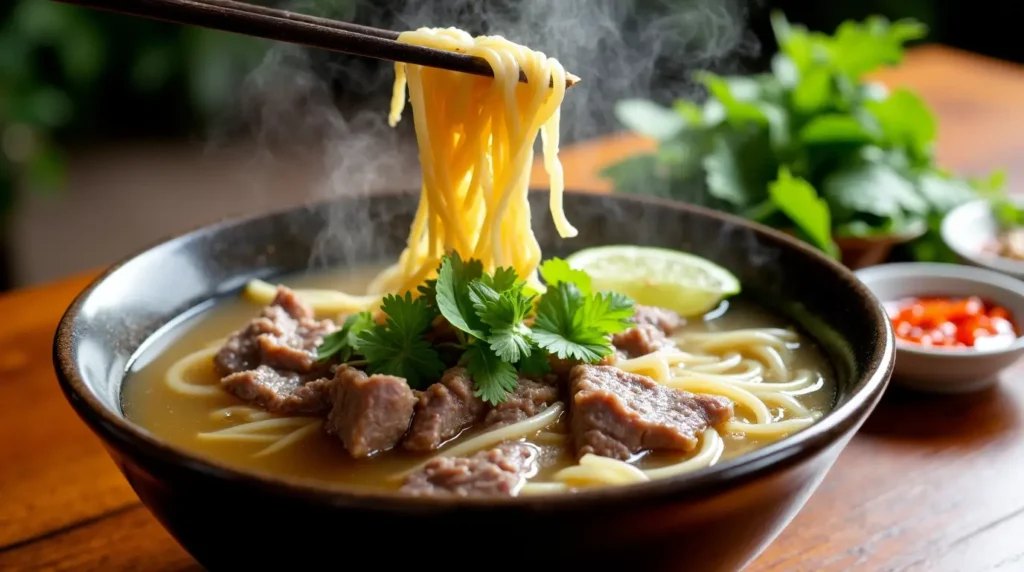
History and Characteristics:
Considered Vietnam’s national dish, phở originated in the early 20th century in the northern region. Influenced by French pot-au-feu (beef stew) and local Chinese noodle soups, it quickly evolved into a hallmark of Vietnamese cuisine and street food culture. The dish typically consists of a clear broth (made by simmering beef or chicken bones with spices like star anise, cinnamon, and ginger), bánh phở (flat rice noodles), and slices of meat.
Regional Variations:
Phở Hà Nội (Northern Style): Subtle flavors, fewer herbs, and a lighter broth.
Phở Sài Gòn (Southern Style): Sweeter broth, often served with a platter of fresh herbs, bean sprouts, and lime.
Simplified Recipe:
Prepare the Broth: In a large pot, bring beef (or chicken) bones to a boil, then discard the water to remove impurities. Refill with fresh water and add charred onion, ginger, star anise, cinnamon sticks, and cloves. Simmer for 2-3 hours, skimming off any foam.
Season and Strain: Season with fish sauce, salt, and a pinch of sugar. Strain the broth to remove solids.
Assemble: Cook rice noodles according to package instructions, then rinse in cold water. Place noodles in a bowl, top with thinly sliced beef (or shredded chicken), and ladle the hot broth over them.
Garnish: Serve with fresh herbs (Thai basil, cilantro), lime wedges, bean sprouts, and optional sliced chili peppers.
Bánh Mì
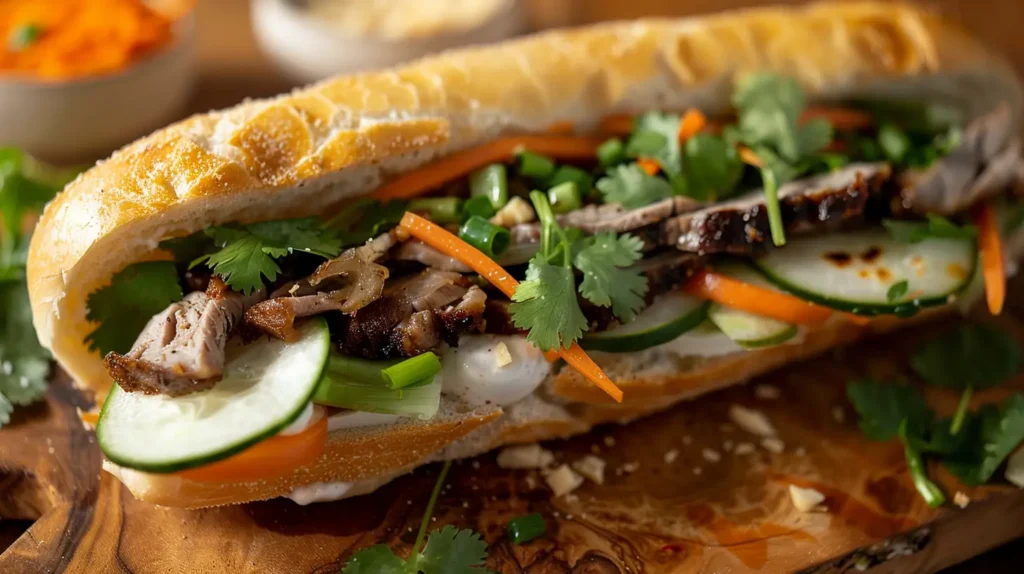
History and Characteristics:
A quintessential example of Franco-Vietnamese culinary fusion, the bánh mì sandwich emerged from the French colonial introduction of the baguette. Today’s Vietnamese baguette is lighter and crisper than its European ancestor, stuffed with an array of fillings like grilled pork, pâté, pickled carrots, daikon, cilantro, and chili. As one of the most internationally recognized dishes in Vietnamese cuisine, bánh mì showcases the country’s ability to adapt and blend global influences while maintaining its unique culinary identity.
Regional Variations:
In the south, bánh mì can include more sauces (like mayonnaise or chili sauce), sweet barbecue pork, and a stronger interplay of sweet and savory flavors.
Northern versions may be simpler, focusing on cold cuts, pâté, and fewer vegetables.
Tips for Making at Home:
Use a crusty baguette and lightly toast it.
Spread pâté and mayonnaise on both sides.
Fill with your favorite protein: grilled pork, chicken, or tofu.
Top with pickled vegetables (carrots and daikon in vinegar and sugar), slices of cucumber, fresh cilantro, and chili if you like heat.
Gỏi Cuốn (Fresh Spring Rolls)
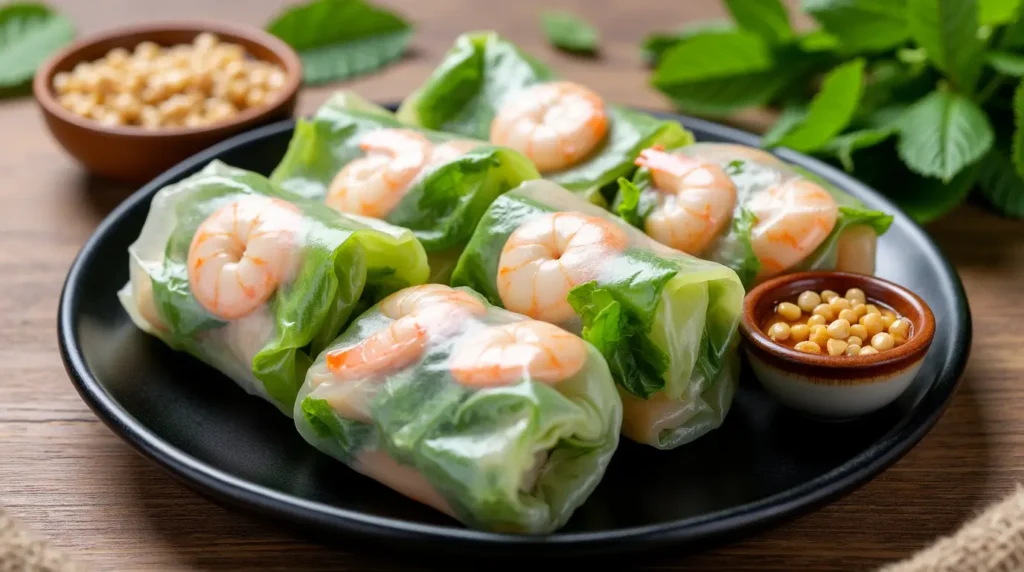
History and Characteristics:
Also known as summer rolls, these translucent rice paper wraps are a refreshing blend of lettuce, herbs, vermicelli noodles, and shrimp or pork. Often served with a peanut-hoisin dipping sauce, they highlight Vietnamese cuisine’s emphasis on fresh, crisp ingredients. This dish exemplifies the balance of flavors and textures that define Vietnam’s culinary traditions, making it a staple in both home cooking and street food culture.
Regional Variations:
Fillings vary, with some regions preferring more herbs, while others include strips of egg or different proteins.
Bánh Xèo (Crispy Pancake)
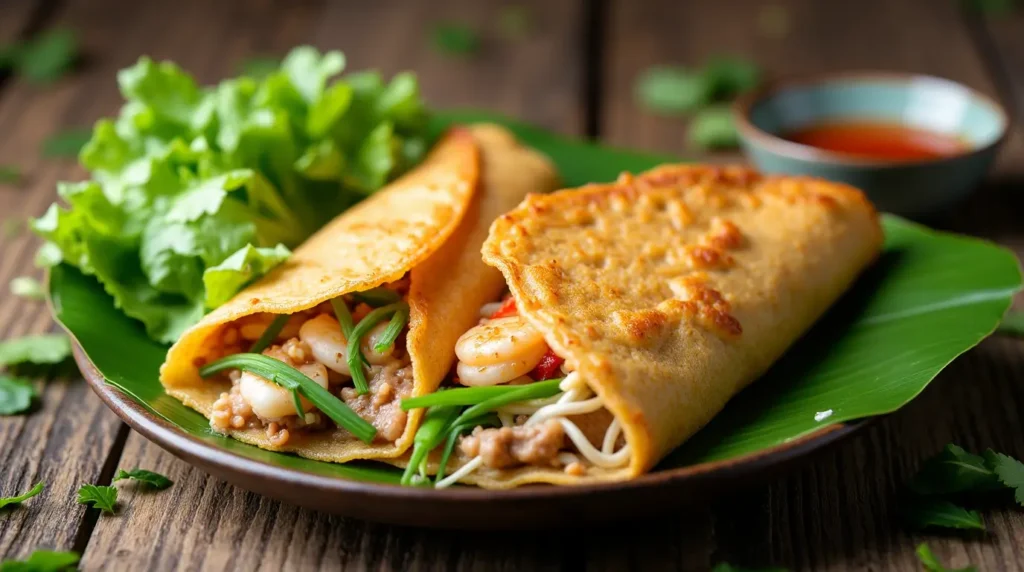
History and Characteristics:
The name literally means “sizzling cake,” after the sizzling sound it makes when rice batter hits a hot pan. A batter of rice flour, water (or coconut milk), and turmeric is filled with shrimp, pork, and bean sprouts, then folded like a crepe. As a beloved dish in Vietnamese cuisine, bánh xèo exemplifies the country’s mastery of texture and contrast—crispy on the outside, yet light and flavorful inside, often enjoyed wrapped in fresh greens and dipped in a tangy fish sauce..
Recipe (Simplified):
Batter: Mix rice flour, turmeric powder, and a pinch of salt with water (or half water, half coconut milk). Let rest for 30 minutes.
Filling: In a hot, oiled skillet, sauté shrimp and thinly sliced pork. Add bean sprouts.
Cook Pancake: Pour a thin layer of batter over the fillings. Cover and let cook until the pancake is crispy and golden on the bottom.
Serve: Fold in half and serve with lettuce, fresh herbs, and a fish sauce-based dipping sauce (nước chấm).
Defining Characteristics of Vietnamese Cuisine
One of the hallmarks of Vietnamese cuisine is its incredible emphasis on balance. Vietnamese dishes skillfully combine:
Spicy: From fresh chili peppers or chili sauces, used more prominently in Central Vietnam.
Sour: Achieved through lime juice, tamarind, or pickled vegetables.
Sweet: Provided by palm sugar, rock sugar, or sweet fruits.
Salty: Courtesy of fish sauce, soy sauce, or salt.
Bitter: Often derived from certain herbs or vegetables like bitter melon (though in more modest amounts).
These elements create a harmonious whole known as the “five fundamental tastes” concept in Eastern culinary philosophy. Texture is also a vital component, with many dishes combining crunchy and soft components (fresh herbs, crunchy pickles, tender meats, and silky noodles).
Seasonings or flavor combinations that stand out include:
Nước Chấm Dipping Sauce: A blend of fish sauce, lime juice, sugar, garlic, and chili, often personalized to taste.
Shallots and Garlic: Foundational aromatics in stir-fries, marinades, and dressings.
Lemongrass: Used in marinades (e.g., for lemongrass chicken or pork) and soups. Its bright, citrusy note is uniquely Vietnamese.
Tamarind: Adds a tangy element to soups like canh chua (sour soup) and certain dipping sauces.
For food enthusiasts seeking new tastes, Vietnamese cuisine’s blend of fresh herbs, nuanced broths, and delicate seasonings offers a delightful exploration of contrasting yet complementary flavors. It appeals to those who appreciate lighter fare without sacrificing depth. The interplay of crunchy, soft, sweet, salty, and tangy is particularly appealing for anyone looking to expand their palate.
Anecdotes and Personal Connection: Eating Vietnamese food often feels like eating with family. Many local eateries are family-run, passing recipes down through generations. This community-oriented approach means you’ll often encounter genuine warmth and hospitality alongside your meal.
Ease of Access: Vietnamese restaurants can be found in many metropolitan areas worldwide. Additionally, thanks to the popularity of Vietnamese cooking, basic ingredients are increasingly available in mainstream grocery stores.
Health Benefits: The heavy focus on herbs, vegetables, and lean proteins makes Vietnamese dishes relatively healthy. Many people who adopt a Vietnamese-style approach to cooking find it easy to maintain a balanced diet.
Budget-Friendly Options: Vietnamese street food culture offers plenty of affordable and delicious meals. A hearty bowl of phở or a bánh mì sandwich can often cost just a few dollars, making it accessible to travelers and locals alike.
Cultural Exploration: Trying Vietnamese cuisine is a window into the country’s history, geography, and daily life. Each dish has a story—whether it’s the influence of Chinese dynasties, French colonization, or local folklore. Exploring these narratives makes the food even more meaningful.
Table Rituals and Customs
Typical Meal Structure
Breakfast: Often a bowl of phở or a loaf of bánh mì filled with egg, meat, or tofu. Vietnamese iced coffee (cà phê sữa đá)—brewed using a drip filter and sweetened with condensed milk—is a beloved morning staple.
Lunch: May feature a bowl of noodles, rice with various side dishes, or even a quick plate of stir-fried vegetables with meat.
Dinner: Traditionally, the main meal in Vietnamese cuisine consists of rice and several shared dishes like stir-fried vegetables, braised meats, and soup. Families gather around a low table, each person having their own small bowl of rice, while the main dishes are in the center for communal sharing. In modern urban areas, work schedules may shift this routine, but these core habits remain widely recognized, especially for family gatherings, reinforcing the deep cultural connection between food and togetherness in Vietnam.
Table Etiquette
Use of Chopsticks: Chopsticks are the main utensils, although spoons are used for soups. It’s considered impolite to stick chopsticks vertically into a bowl of rice, as it resembles incense offerings for the deceased.
Communal Sharing: Dishes are placed in the center, and everyone helps themselves. It’s polite to take modest portions so others can also enjoy.
Respect for Elders: In a traditional Vietnamese family setting, the youngest might serve rice to the elders first, and everyone waits until the elders begin eating.
No Wasting Food: Food waste is frowned upon. It’s customary to finish all the grains of rice in your bowl out of respect for the effort that went into producing it.
National Holidays, Religious Events, and Family Celebrations
Tết (Lunar New Year): The most significant holiday in Vietnam, marking the beginning of the lunar calendar. Families prepare special dishes that are deeply rooted in Vietnamese cuisine, such as bánh chưng (sticky rice cakes with pork and mung beans) in the north and bánh tét in the south. Mứt Tết (candied fruits and seeds) are offered to guests, symbolizing prosperity and reflecting the holiday’s emphasis on sharing and abundance.
Mid-Autumn Festival (Tết Trung Thu): Mooncakes filled with lotus seed paste, salted egg yolks, or red bean paste are a highlight. Children parade with lanterns, and families gather to enjoy sweet treats and tea.
Weddings and Funerals: Food plays a crucial role in these family ceremonies. Weddings often feature elaborate banquet menus, while funerals observe rituals of offering food to ancestors.
Ancestor Worship: Many Vietnamese households maintain an ancestral altar, where offerings of fruits, cakes, and sometimes savory dishes are made on auspicious days.
Modern Trends and Culinary Fusions
Evolving Through Contact with Other Gastronomies
Contemporary Vietnamese chefs are increasingly drawing inspiration from global cuisines, integrating ingredients like cheese, olive oil, or Western herbs (oregano, rosemary) into traditional dishes. Fusion restaurants in major cities like Hanoi, Da Nang, and Ho Chi Minh City offer novel takes on classics—phở with foie gras, or bánh xèo with kimchi fillings, for instance.
This innovative approach reflects the adaptability of Vietnamese cuisine, which continues to evolve while maintaining its deep-rooted culinary principles. Culinary schools and cooking classes that cater to tourists and aspiring local chefs also facilitate an exchange of ideas. The result is a vibrant, evolving dining scene that still respects time-honored traditions but isn’t afraid to experiment.
New Consumption Trends
Vegetarianism and Veganism: A growing movement, partly influenced by global trends and Buddhism (which advocates vegetarian meals on certain days), has led to more plant-based versions of popular Vietnamese cuisine dishes. Tofu, mushrooms, and jackfruit often replace meats, allowing traditional flavors and cooking techniques to shine while catering to vegetarian and vegan diets.
Farm-to-Table and Organic Food: Concerns about pesticide use have encouraged small-scale farmers to grow organic produce and supply farm-to-table restaurants. This trend resonates with traditional Vietnamese values of freshness and seasonality.
Health and Wellness Focus: Many younger urbanites are adopting diets that emphasize low-fat, low-sugar, and low-salt options. Popular items include salads made with local herbs, fresh juices, and smoothies featuring tropical fruits.
Young Chefs and Restaurateurs
Across Vietnam, a new generation of chefs is reimagining staples. They might deconstruct a classic dish, plating it in a modern style, or introduce haute-cuisine techniques like sous-vide. Some well-known young Vietnamese chefs have gained international acclaim through cooking competitions and media exposure, further elevating Vietnamese cuisine and Vietnam’s reputation as a culinary hotspot.
Their restaurants serve as innovation hubs, drawing from local markets for fresh ingredients while embracing global cooking methods, ensuring that Vietnamese cuisine continues to evolve while staying true to its rich heritage.
Conclusion and Call to Action
Vietnamese cuisine is a symphony of flavors and textures—one shaped by thousands of years of history, cross-cultural exchanges, and the creativity of cooks both past and present. From the quiet countryside markets to the lively street stalls in big cities, each region’s unique touch tells a broader narrative of resilience, innovation, and communal spirit.
We’ve explored Vietnam’s culinary context and history, taking a close look at the influences that have made the cuisine so vibrant. We’ve seen how geography, climate, colonization, and migrations all played a role. We’ve highlighted key ingredients like fish sauce, rice, herbs, and local produce, without which Vietnamese dishes simply wouldn’t be the same. We delved into must-try dishes, from the globally beloved phở and bánh mì to fresh spring rolls and crispy bánh xèo. We also uncovered how different regions—north, center, and south—bring their own flavors and techniques to the table.
Defining characteristics like balanced flavors, abundant fresh herbs, and a keen focus on texture set Vietnamese cuisine apart from other world cuisines. Whether you’re seeking subtle soups or fiery broths, there’s something for every palate. Along the way, we’ve shared tips and anecdotes to encourage you to give this cuisine a try, reminding you that it’s not only delicious but also relatively healthy and deeply reflective of a rich cultural heritage.
Dining customs in Vietnam emphasize communal bonding and respect, while major festivals like Tết bring out special dishes that showcase the nation’s strong family and cultural values. In modern times, Vietnamese chefs are blending tradition with global inspirations, offering vegetarian options, farm-to-table concepts, and inventive fusion dishes that keep the cuisine dynamic and forward-looking.
Now, we’d love to hear from you! Have you tried Vietnamese food before, or perhaps attempted cooking a dish at home? Share your experiences, your favorite recipes, or any questions you have about sourcing authentic ingredients. If you’re new to Vietnamese cuisine, let this article be your stepping stone into a world of fragrant noodles, crisp herbs, and irresistible broths.
Future Topic Teaser: In a follow-up piece, we’ll delve deeper into the art of Vietnamese street food culture—focusing on the hidden gems of night markets, the evolution of quick bites like bánh mì, and how street vendors maintain age-old traditions in a rapidly modernizing society. Stay tuned!
By immersing yourself in the flavors, aromas, and stories of Vietnamese cuisine, you embark on a gastronomic adventure that is both comforting and thrilling. Whether you do it from your own kitchen or explore street stalls in Vietnam, allow your senses to guide you through this rich tapestry of taste. Your palate—and your sense of cultural discovery—will be all the richer for it.

